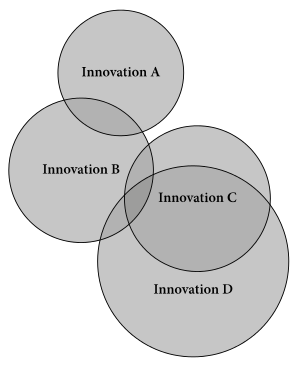
Back نموذج الموجة (لغويات) Arabic Wellentheorie (Linguistik) German Laineteooria (lingvistika) Estonian Théorie des vagues French Tonnteoiric Irish Teoría das ondas Galician תורת הגלים (בלשנות) HE Ալիքների տեսություն (լեզվաբանություն) Armenian Teori gelombang ID Teoria delle onde Italian
This article needs additional citations for verification. (January 2012) |

In historical linguistics, the wave model or wave theory (German: Wellentheorie) is a model of language change in which a new language feature (innovation) or a new combination of language features spreads from its region of origin, being adopted by a gradually expanding cluster of dialects. Each innovation starts at a certain place, and spreads from speaker to speaker, from dialect to dialect, in the same fashion as waves on the water.[1][2]
The theory was intended as a substitute for the tree model, which did not seem to be able to explain the existence of some features, especially in the Germanic languages, by descent from a proto-language. At its most ambitious, it is a wholesale replacement for the tree model of languages.[2] During the 20th century, the wave model had little acceptance as a model for language change overall, except for certain cases, such as the study of dialect continua and areal phenomena; it has recently gained more popularity among historical linguists, due to the shortcomings of the tree model.[2][3]
- ^ Cite error: The named reference
Wolframwas invoked but never defined (see the help page). - ^ a b c Cite error: The named reference
francoiswas invoked but never defined (see the help page). - ^ Heggarty, Paul; Maguire, Warren; McMahon, April (2010). "Splits or waves? Trees or webs? How divergence measures and network analysis can unravel language histories". Philosophical Transactions of the Royal Society B. 365 (1559): 3829–3843. doi:10.1098/rstb.2010.0099. PMC 2981917. PMID 21041208..